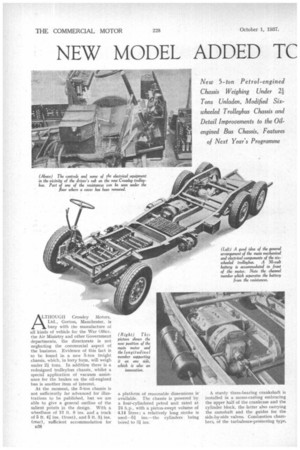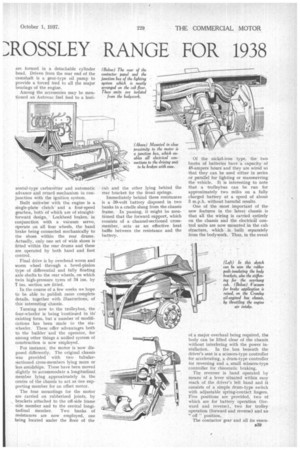NEW MODEL ADDED IC
Page 48

Page 49

Page 50

If you've noticed an error in this article please click here to report it so we can fix it.
1:ROSSLEY RA \-GE FOR 1938
New 5-ton Petrol-engined Chassis Weighing Under Tons Unladen, Modified Sixwheeled Trolleybus Chassis and Detail Improvements to the Oilengined Bus Chassis, Features of Next Year's Programme
ALTHOUGH Crossley Motors, Ltd., Gorton, Manchester, is busy with the manufacture of all kinds of vehicle for the War Office, the Air Ministry and other Government departments, the directorate is not neglecting the commercial aspect of the business. Evidence of this fact is to be found in a new 5-ton freight chassis, which, in lorry form, will weigh under 2i tons. In addition there is a redesigned trolleybus chassis, whilst a special application of vacuum assistance for the brakes on the oil-engined bus is another item of interest.
At the moment, the 5-ton chassis is not sufficiently far advanced for illustrations to he published, hut we are able to give a general outline of the salient points in the design. With a wheelbase of 13 ft. 8 ins, and a track of 5 ft. 4; ins. (front), and 5 ft. 3i ins. (rear), sufficient accommodation for B38 a platform of reasonable dimensions is available. The chassis is powered by a four-cylindered petrol unit rated at 24 h.p., with a piston-swept volume of 4.14 litres ; a relatively long stroke is used-5i ins.—the cylinders being bored to A sturdy three-bearing crankshaft is installed in a mono-casting embracing the upper half of the crankcase and the cylinder block, the latter also carrying the camshaft and the guides for the side-by-side valves. Combustion chambers, of the turbulence-promoting type, zontal-type carburetter and automatic advance and retard mechanism in conjunction with the ignition system.
Built unitwise with the engine is a single-plate clutch and a four-speed gearbox, both of which are of straightforward design. Lockheed brakes, in conjunction with a vacuum servo, operate on all four wheels, the hand brake being connected mechanically to the shoes within the rear drums. Actually, only one set of wide shoes is fitted within the rear drums and these are operated by both hand and foot control.
Final drive is by overhead worm and worm wheel through a bevel-pinion type of differential and fully floating axle shafts to the rear wheels, on which twin high-pressure tyres of 34 ins. by 7 ins. section are fitted.
In the course of a few weeks we hope to be able to publish more complete details, together with illustrations, of this interesting chassis.
Turning now to the trolleybus, the four-wheeler is being tontinued in its' existing form, but a number of modifications has been made to the sixwheeler. These offer advantages both to the builder and the operator, for among other things a unified system of construction is now employed.
For instance, the motor is now disposed differently. The original chassis was provided with two tubularsectioned cross-members lying more or less amidships. These have been moved slightly to accommodate a longitudinal member lying approximately in the centre of the chassis to act as one supporting member for an offset motor.
The four mountings for the motor are carried on rubberized joints, by brackets attached to the off-side frame side member and to the central longitudinal member. Two banks of resistances are now employed, one being located under the floor of the cab and the other lying behind the rear bracket for the front springs.
Immediately behind these resistances is a 30-volt battery disposed in two banks in a cradle slung from the chassis frame. In passing, it might be mentioned that the forward support, which consists of a channel-sectioned crossmember, acts as an effective heat baffle between the resistance and the battery. Of the nickel-iron type, the two banks of batteries have a capacity of 48-ampere hours and they are wired so that they can be used either in series or parallel for lighting or manoeuvring the vehicle. It is interesting to note that a trolleybus can be run for approximately two miles on a fully charged battery at a speed of about 3 m.p.h. without harmful results.
One of the most important of the new features in the latest chassis is that all the wiring is carried entirely on the chassis and the electrical control units are now mounted in the cab structure, which is built separately from the bodywork. Thus, in the event of a major overhaul being required, the body can be lifted clear of the chassis without interfering with the power installation. In the box beneath the driver's seat is a scissors-type controller for accelerating, a drum-type controller for reversing and a small scissors-type controller for rheostatic braking.
The reverser is hand operated by means of a lever situated within easy reach of the driver's left hand and it consists of a simple drum-type switch with adjustable spring-contact fingers. Five positions are provided, two of which are for battery operation (forward and reverse), two for trolley operation (forward and reverse) and an " off " position.
The contactor gear and all its essen330 Gal wiring is mounted on a sub-frame built up from the cab floor with the wiring behind the panel ; a suitable trap-door built into the forward bulkhead of the body gives access to the connections. It is worth noting here that the wiring is arranged in four groups, each of which runs through rubber tubing.
Another alteration concerns the braking system. Originally, regenerative and rheostatic braking were controlled by the left pedal. In the new design this pedal controls only regenerative braking, rheostatic braking being operated by the brake pedal and the wiring is arranged so that it is necessary for the driver to pass through his rheostatic brake before reaching the air brake.
The battery series-parallel switch, the compressor-control switch, together with the instrument panel and dewirement indicator, are now mounted on a panel on the chassis.
A steel-shell body of the usual double-deck type is a standard product, except for the method of mounting. The body sill is carried at 10 points on brackets outrigged from the frame side-members with thick rubber blocks interposed between the brackets and the body frame, further blocks of rubber being placed between the underside of the brackets and the clamping plates. The foremost support is in line with the front bulkhead of the body, and thus the cab is overhung. To restrict any excessive vertical movement, a deep channel-sectioned longi
tudinal member is built into the framing and runs.from the front bulkhead of the body to the front panel of the cab, an additional reinforcement being effected by plates riveted through the outer framing for the body. A concealed type of gantry is used in the latest design with a lead-in for the power through a suitably insulated rectangular-shaped hole in the roof.
Regarding the modifications made to the oil-engined bus chassis, the chief item of interest concerns the arrangement of the braking which, as in the past, incorporates a servo for the pedalapplied system, but, instead of employing a rotary exhauster, the air intake for the manifold is throttled to afford the necessary depression for the vacuum-servo motor. In the air intake, a throttle valve is arranged so that it is operated from the accelerator pedal and, in its closed position, sufficient air is allowed to pass to enable the engine to idle satisfactorily, but as the accelerator is depressed the throttle valve is, of course, opened. To avoid
any possibility of stalling, a lostmotion coupling is installed between the throttle and the accelerator pedal, thereby enabling the engine to be• accelerated slightly without affecting the setting of the air-intake throttling valve.




















































































